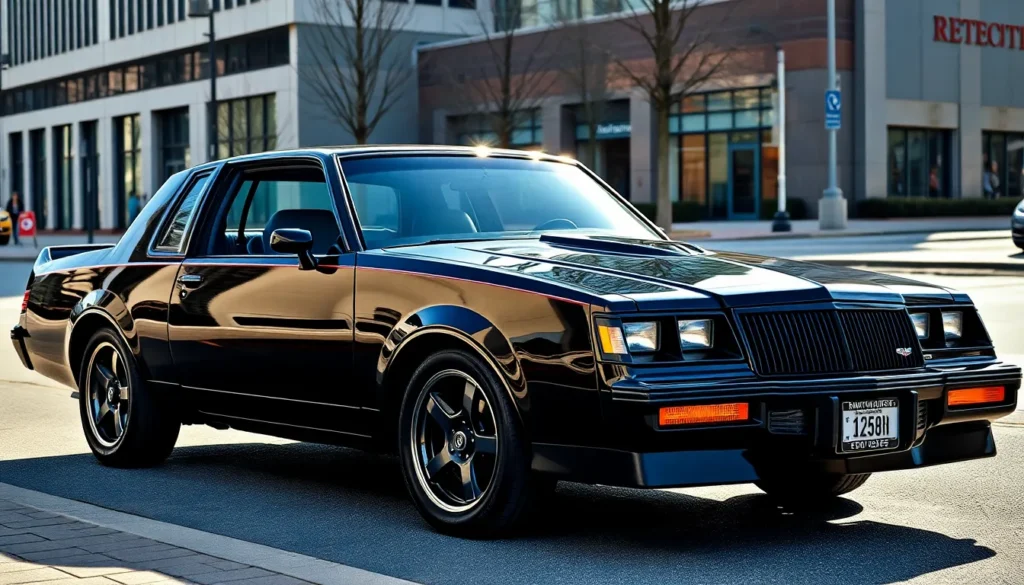The Buick Grand National remains one of America’s most legendary muscle cars and we’re here to tell you why this dark knight deserves every bit of its cult following. Born during the mid-1980s when performance cars were supposedly dying this menacing black beast proved that American muscle wasn’t going anywhere.
We’ve watched car enthusiasts debate for decades about what makes a true classic but the Grand National settles that argument quickly. With its sinister all-black appearance and turbocharged V6 that could outrun Corvettes this wasn’t just another pretty face in the showroom. It was a statement that Buick could build something seriously fast.
What makes this car so special isn’t just its impressive quarter-mile times or its intimidating presence. We’re talking about a vehicle that redefined what we expected from both Buick and American performance cars forever changing how we view turbocharged engines in muscle car culture.
The Legend of the Buick Grand National
The Buick Grand National transcended traditional automotive boundaries to become America’s most unexpected performance icon. Born from Buick’s partnership with NASCAR’s Grand National racing series, this dark horse emerged in 1982 as a limited production model that would redefine muscle car expectations.
General Motors faced important challenges during the early 1980s fuel crisis, with most manufacturers abandoning high-performance vehicles. Buick engineers took a different approach by developing the Grand National’s turbocharged 3.8-liter V6 engine, which generated 245 horsepower in its final 1987 iteration. This powerplant delivered remarkable acceleration figures that stunned automotive enthusiasts across the country.
Performance metrics tell the Grand National’s remarkable story. The 1987 model achieved 0-60 mph acceleration in just 4.7 seconds, making it faster than the contemporary Chevrolet Corvette. Quarter-mile times consistently registered in the mid-13-second range, with trap speeds exceeding 100 mph. These numbers placed the Grand National among the quickest production cars available during the Reagan era.
Automotive journalists initially questioned Buick’s ability to produce a legitimate performance car. Motor Trend magazine famously declared the Grand National “quickest American car” in 1986, while Car and Driver praised its surprising handling capabilities even though the front-heavy weight distribution. Road tests consistently showed the Grand National outperforming traditional V8-powered muscle cars from Ford and Chrysler.
Production numbers emphasize the Grand National’s exclusivity and desirability. Buick manufactured only 20,193 Grand Nationals between 1982 and 1987, with the final model year accounting for 20,193 units. The even rarer GNX variant saw just 547 examples leave the factory, making it one of the most collectible American performance cars ever produced.
Racing heritage provided the Grand National’s foundation and credibility. NASCAR’s Grand National series inspired the car’s name and performance philosophy, though the production vehicle used a different engine configuration than its racing counterparts. This connection to motorsports helped establish the Grand National’s reputation among serious performance enthusiasts who previously dismissed Buick as a luxury car manufacturer.
Cultural impact extended far beyond automotive circles, with the Grand National appearing in movies, television shows, and music videos throughout the late 1980s. Hip-hop artists frequently referenced the car in lyrics, while Hollywood productions featured its menacing black exterior in action sequences. This mainstream exposure elevated the Grand National from niche performance car to cultural phenomenon.
Performance and Engine Specifications
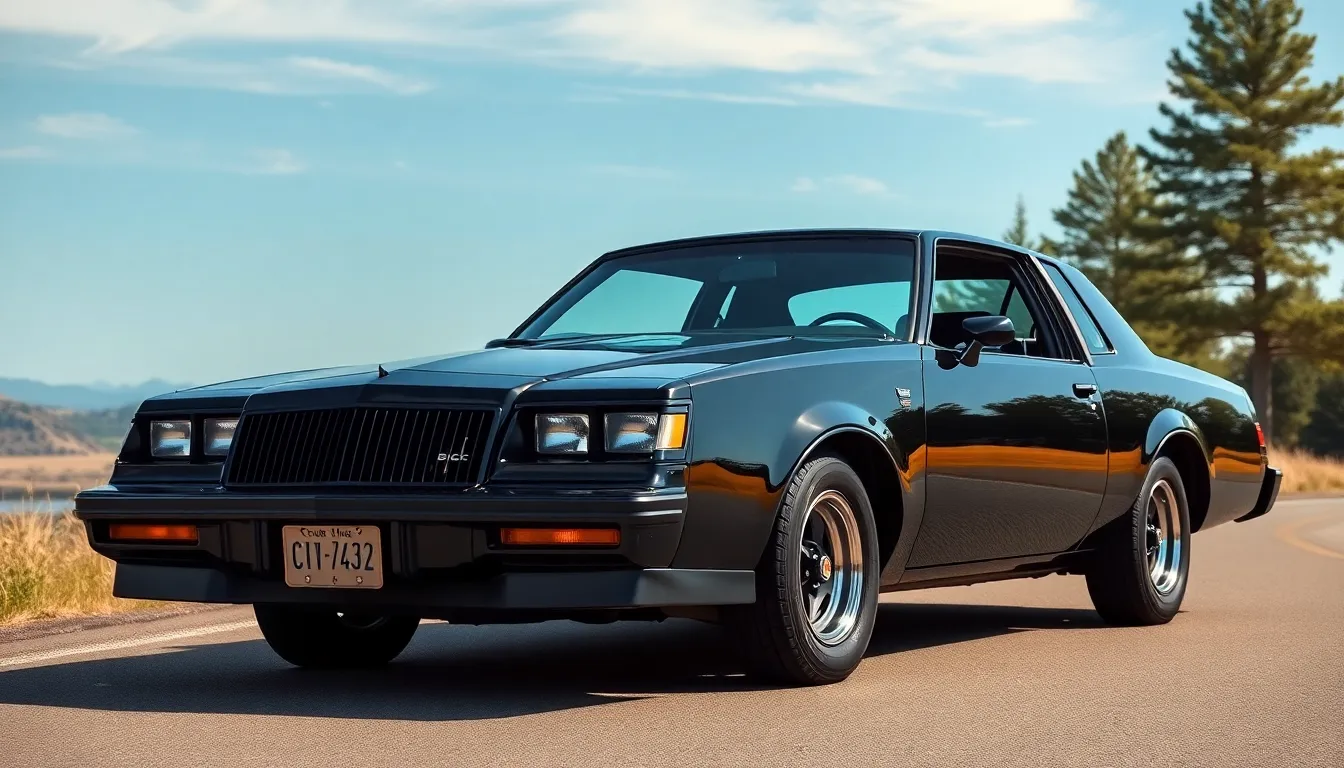
The Buick Grand National’s performance credentials stem from its innovative turbocharged powerplant and impressive acceleration figures. This muscle car’s engine specifications distinguished it from traditional V8 powered competitors of the era.
The Turbocharged 3.8L V6 Engine
Buick engineers developed the turbocharged 3.8-liter V6 engine to deliver exceptional performance during an era when fuel efficiency dominated automotive priorities. The engine featured a Garrett T3 turbocharger that forced compressed air into the combustion chambers, significantly increasing power output compared to naturally aspirated engines. Sequential fuel injection replaced traditional carburetion, providing precise fuel delivery under boost conditions.
The V6 configuration utilized a cast iron block with aluminum cylinder heads, creating a robust foundation for turbocharger operation. Intercooling systems reduced intake air temperatures, allowing for higher boost pressures without detonation concerns. Electronic engine management controlled ignition timing and fuel mixture ratios, optimizing performance across the entire RPM range.
Internal engine components received strengthening modifications to handle increased cylinder pressures from forced induction. Forged pistons and connecting rods replaced standard components in later production years. The crankshaft featured additional counterweights to smooth vibrations inherent in V6 engine designs.
Power Output and Acceleration
The Grand National’s turbocharged V6 produced varying power outputs throughout its production run, with peak performance achieved in the final 1987 model year.
| Model Year | Horsepower | Torque (lb-ft) | 0-60 mph (seconds) |
|---|---|---|---|
| 1982 | 200 | 300 | 7.0 |
| 1984-1985 | 200 | 300 | 6.1 |
| 1986 | 235 | 330 | 5.0 |
| 1987 | 245 | 355 | 4.7 |
Maximum horsepower reached 245 in 1987, accompanied by 355 lb-ft of torque that peaked at just 2,000 RPM. This torque curve provided exceptional low-end pulling power, enabling rapid acceleration from standstill conditions. The engine’s broad torque band extended from 2,000 to 4,000 RPM, making it highly effective for street driving scenarios.
Quarter-mile performance figures placed the 1987 Grand National among the quickest production cars of its era, achieving elapsed times of 13.4 seconds at trap speeds exceeding 105 mph. These acceleration numbers surpassed the contemporary Chevrolet Corvette’s performance benchmarks, establishing the Grand National as America’s fastest production sedan.
Boost pressure operated at approximately 15 PSI in stock configuration, with the turbocharger spooling rapidly due to the engine’s relatively small displacement. This quick turbo response minimized lag time, providing immediate throttle response that enhanced the driving experience compared to larger displacement turbocharged engines of the period.
Design and Styling Features

Design elements of the Buick Grand National created an unmistakably menacing presence that set it apart from every other production car of the 1980s. Distinctive styling features combined function with form to produce a vehicle that looked as fast as it performed.
Exterior Design Elements
Monochromatic black paint dominated every exterior surface of the Grand National, earning it the nickname “Darth Vader’s car” among enthusiasts. Blacked-out chrome trim replaced traditional bright work on bumpers, window surrounds, and door handles to maintain the sinister aesthetic. Special aluminum wheels featuring a distinctive turbine design came exclusively in black or dark gray finishes to complement the overall theme.
Aerodynamic improvements included a front air dam that enhanced airflow to the intercooler while reducing lift at high speeds. Functional hood vents allowed hot air to escape from the engine bay, preventing heat buildup that could affect turbocharger performance. Rear spoiler integration maintained clean lines while providing subtle downforce at highway speeds.
Grand National badges replaced standard Regal emblems on the rear deck and front fenders, while “Turbo 6” callouts on the front fenders announced the car’s unique powerplant. Body-colored mirror caps and window trim created a seamless appearance that eliminated visual breaks in the design. Special “Grand National” script appeared on the rear bumper in silver lettering for subtle identification.
Interior Layout and Comfort
Interior appointments in the Grand National balanced performance focus with luxury comfort expected from a Buick product. Bucket seats featured special cloth upholstery with gray and black color schemes that complemented the exterior theme. Center console design incorporated a large storage compartment and featured the distinctive floor-mounted shifter for the four-speed automatic transmission.
Dashboard layout included analog gauges with white faces and red needles for improved visibility during spirited driving. Turbo boost gauge replaced the standard vacuum gauge to provide real-time feedback on engine performance. Climate control systems maintained the same functionality as standard Regal models while featuring black bezels to match the interior color scheme.
Door panels received special trim pieces with Grand National badging and featured power window switches in all models. Rear seat accommodations provided adequate space for two adult passengers with fold-down armrests for extended comfort. Cargo area maintained the same 14.2 cubic feet of storage space as the standard Regal while featuring a spare tire mounted in the trunk floor.
Driving Experience and Handling
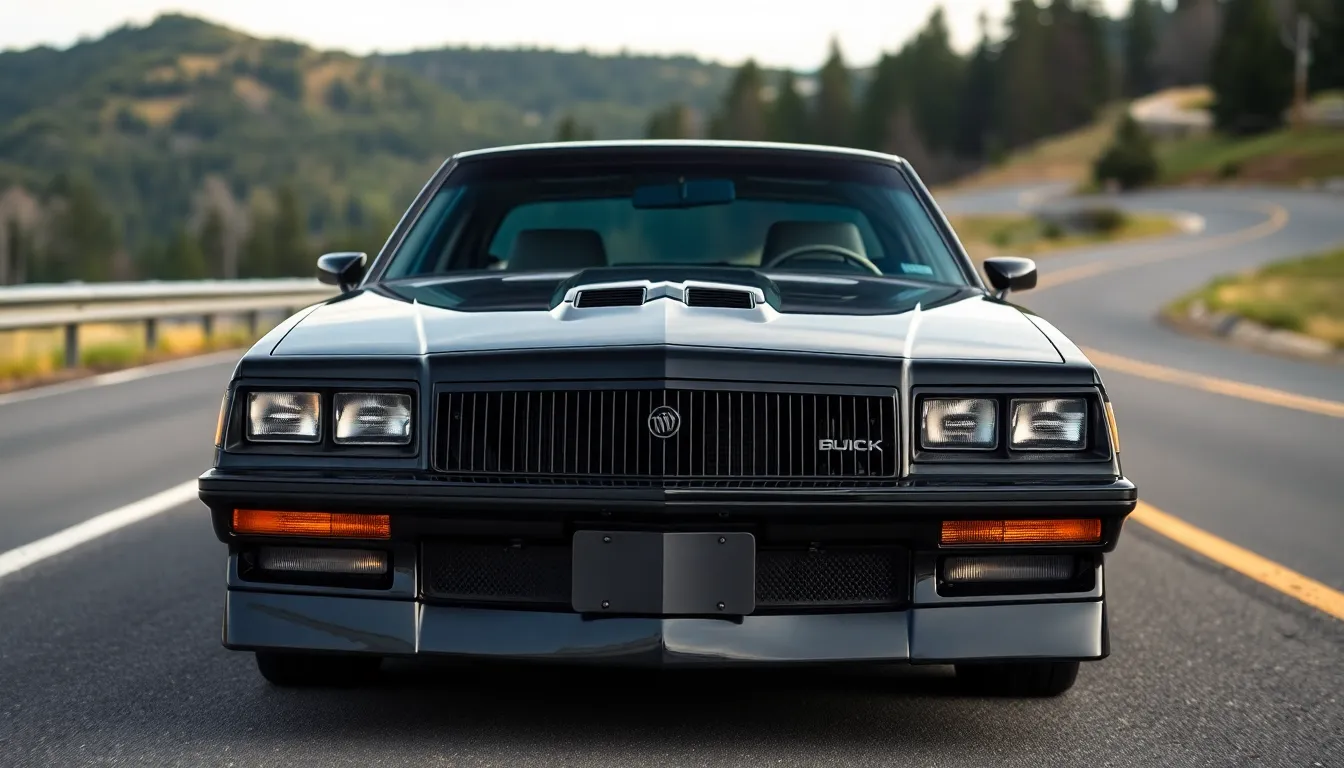
Driving experience in the Buick Grand National delivers an entirely different sensation compared to traditional V8 muscle cars. The turbocharged V6 engine produces immediate power delivery once the turbo spools up at approximately 2,000 rpm. This characteristic creates a distinctive surge of acceleration that distinguishes the Grand National from naturally aspirated competitors.
Handling characteristics reflect the car’s unique engineering approach. The front suspension uses MacPherson struts with stabilizer bars, while the rear features a solid axle with four-link design and coil springs. This setup provides predictable cornering behavior even though the car’s 3,545-pound curb weight. The suspension tuning balances comfort with performance, maintaining composure during aggressive driving while offering acceptable ride quality for daily use.
Steering feedback comes through a recirculating ball system that requires more input than modern rack-and-pinion setups. The steering ratio of 15.6:1 demands deliberate inputs but provides adequate road feel for spirited driving. Power steering assistance makes parking manageable even though the system’s older design philosophy.
Braking performance relies on front disc brakes measuring 10.5 inches in diameter and rear drum brakes. The brake system adequately handles the car’s performance capabilities, though fade resistance becomes a concern during extended high-performance driving sessions. The brake pedal offers reasonable feel and modulation for typical driving scenarios.
Transmission engagement through the four-speed automatic creates smooth shifts under normal conditions. The transmission’s lock-up torque converter improves highway efficiency while maintaining the engine’s power delivery characteristics. Manual shift capability allows drivers to hold gears longer, maximizing turbo boost pressure during acceleration runs.
Road manners showcase the Grand National’s dual personality. Cruising behavior remains comfortable and composed, with the turbo V6 providing adequate low-end torque for city driving. Highway performance excels once the turbo builds pressure, delivering strong passing power that rivals contemporary V8 engines. The exhaust note produces a distinctive whistle from the turbo system, creating an audible signature that enthusiasts recognize immediately.
Weight distribution sits at 58 percent front and 42 percent rear, creating slight understeer tendencies during cornering. This balance promotes predictable handling characteristics that most drivers can manage safely. The car responds well to throttle adjustments mid-corner, allowing experienced drivers to influence the handling balance through power application.
Collectibility and Market Value
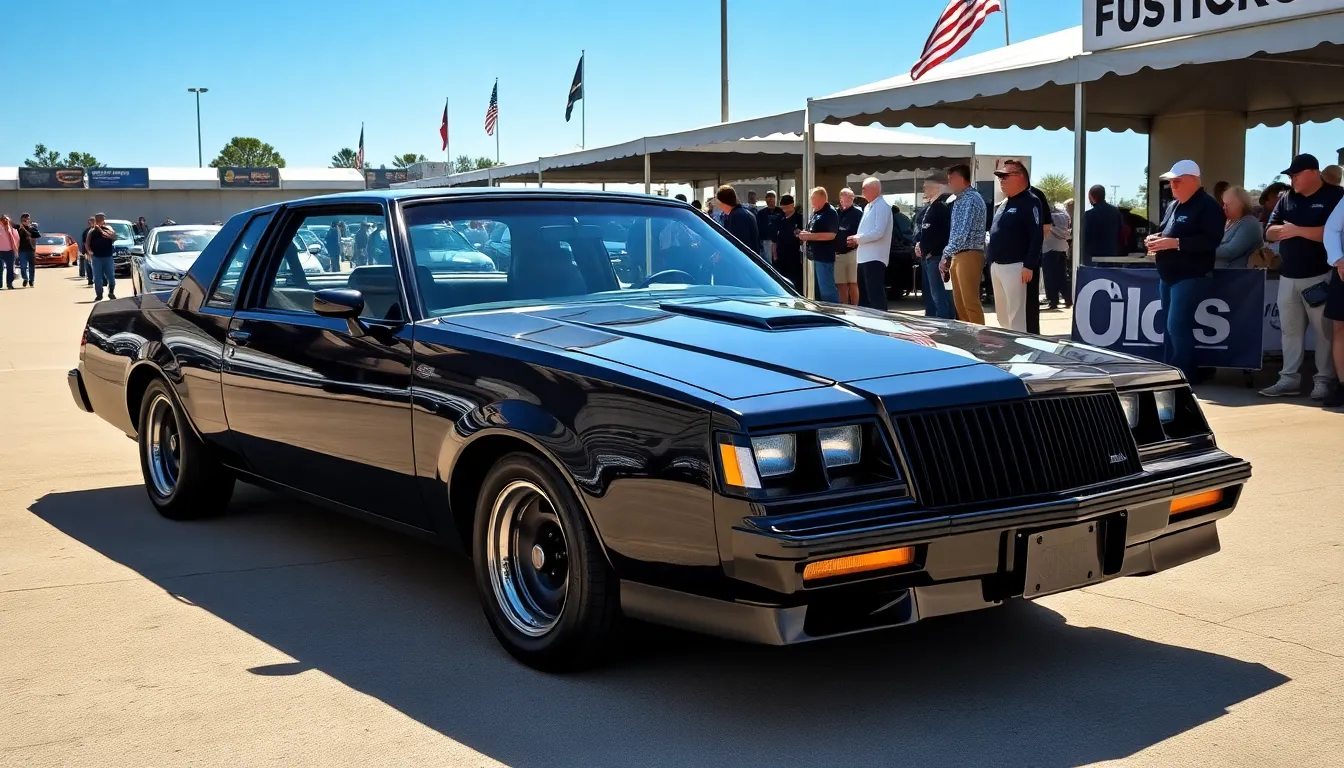
We observe the Buick Grand National commanding remarkable collector interest and strong market values that continue appreciating across all conditions. Its limited production run combined with racing heritage creates sustained demand among enthusiasts and investors alike.
Current Market Trends
Grand National values demonstrate consistent upward trajectory across multiple condition categories throughout 2023-2024. Concours-quality examples fetch $85,000-$120,000 at prestigious auctions like Barrett-Jackson and Mecum. Excellent condition vehicles trade between $45,000-$65,000 while good condition examples maintain $25,000-$35,000 ranges.
GNX variants command premium pricing that reflects their extreme rarity. These 547-unit production vehicles achieve $200,000-$300,000 at auction depending on mileage and documentation. Low-mileage GNX examples with original window stickers and dealer documentation exceed $350,000 in recent sales.
Regional markets show varying price points based on local collector preferences. California and Florida markets demonstrate highest values due to concentrated collector populations. Midwest markets offer opportunities for acquisition at 10-15% below national averages.
Original documentation significantly impacts valuations across all Grand National variants. Build sheets increase values by $3,000-$5,000 while original window stickers add $2,000-$3,000 premiums. Complete service records enhance desirability and support asking prices in competitive markets.
Investment Potential
Grand National appreciation rates exceed broader classic car market performance by substantial margins. Hagerty Price Guide data indicates 127% value increases over the past decade compared to 78% for the overall classic car index.
Market fundamentals support continued appreciation through multiple factors:
- Production Scarcity: Only 20,193 total units manufactured creates finite supply
- Generational Appeal: 1980s nostalgia drives millennial collector interest
- Performance Credentials: Quarter-mile times remain impressive by modern standards
- Cultural Significance: Hip-hop culture associations maintain relevance
Low-mileage survivors represent strongest investment candidates due to their preservation and documentation. Examples under 30,000 original miles achieve premium valuations and demonstrate superior appreciation rates. High-mileage drivers still appreciate but at slower rates reflecting their utility rather than collectible status.
Restoration candidates offer entry points for budget-conscious collectors but require careful evaluation. Complete restorations cost $15,000-$25,000 for quality work while potentially adding $10,000-$15,000 in value when properly executed. Original paint and interior components command premiums that justify preservation over restoration.
Market liquidity remains strong with consistent auction activity and private sales. Enthusiast forums and specialty dealers help transactions while maintaining price transparency. Insurance companies recognize Grand National values through agreed-value policies that protect collector investments.
Common Issues and Maintenance
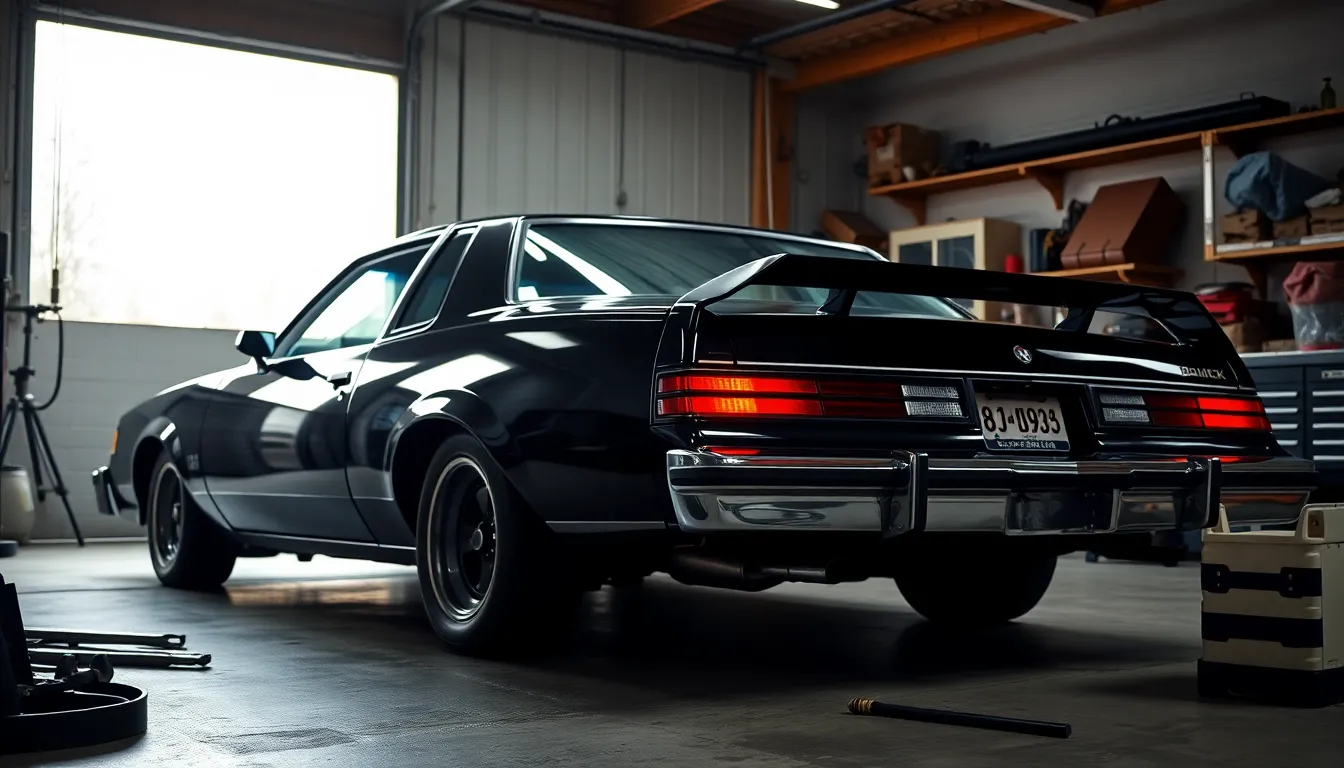
Common issues plague Grand National ownership even though the model’s legendary performance reputation. Turbo-related problems emerge as the most frequent concern, with wastegate actuators failing after 80,000 miles and intercooler efficiency degrading over time. Engine knock becomes problematic when owners use regular gasoline instead of the required premium fuel, while vacuum leaks develop in the extensive turbo plumbing system.
Transmission maintenance requires exact attention since the 200-4R automatic transmission experiences valve body wear patterns unique to turbocharged applications. Overheating occurs during aggressive driving sessions when the transmission cooler becomes insufficient, leading to premature clutch band failure. Converter lockup issues manifest between 45-55 mph when solenoids malfunction or hydraulic pressure drops below specifications.
Electrical gremlins affect multiple systems including the electronic spark control module that regulates turbo boost levels. Fuel pump relay failures strand owners unexpectedly, while the digital dash displays develop segment failures in temperatures above 90°F. Power window motors seize in the down position, and door lock actuators fail within the driver’s side panel assembly.
Suspension components wear faster than standard Regal models due to increased torque loads and aggressive driving patterns. Front strut towers crack near the mounting points after 100,000 miles, while rear axle bushings deteriorate rapidly under hard acceleration stress. Brake rotors warp frequently since the stock cooling system can’t handle repeated high-speed stops effectively.
| Maintenance Item | Interval | Cost Range |
|---|---|---|
| Turbo oil change | 3,000 miles | $75-$120 |
| Intercooler cleaning | 15,000 miles | $150-$250 |
| Transmission service | 30,000 miles | $200-$350 |
| Timing chain inspection | 60,000 miles | $400-$600 |
| Fuel injector cleaning | 45,000 miles | $300-$450 |
Preventive maintenance extends Grand National lifespan when owners follow turbocharged-exact service protocols. Oil changes every 3,000 miles prevent turbo bearing damage, while synthetic oil provides better high-temperature protection than conventional alternatives. Coolant system flushes every 24 months prevent electrolysis damage in aluminum components, and fuel filter replacements every 15,000 miles maintain proper injection pressure.
Parts availability creates restoration challenges since Buick discontinued many Grand National-exact components decades ago. Reproduction parts exist for exterior trim pieces and interior components, but original turbo assemblies command premium prices between $3,500-$5,000 when available. Aftermarket support thrives through specialty vendors who manufacture performance upgrades and maintenance items specifically for Grand National applications.
Professional service becomes essential when addressing turbo system repairs or transmission rebuilds beyond basic maintenance tasks. Shops experienced with turbocharged Buicks charge $125-$165 per hour for diagnostic work, while general mechanics often misdiagnose boost-related problems. Documentation of all service work increases resale value and provides future owners with maintenance history records.
The Grand National’s Legacy and Impact
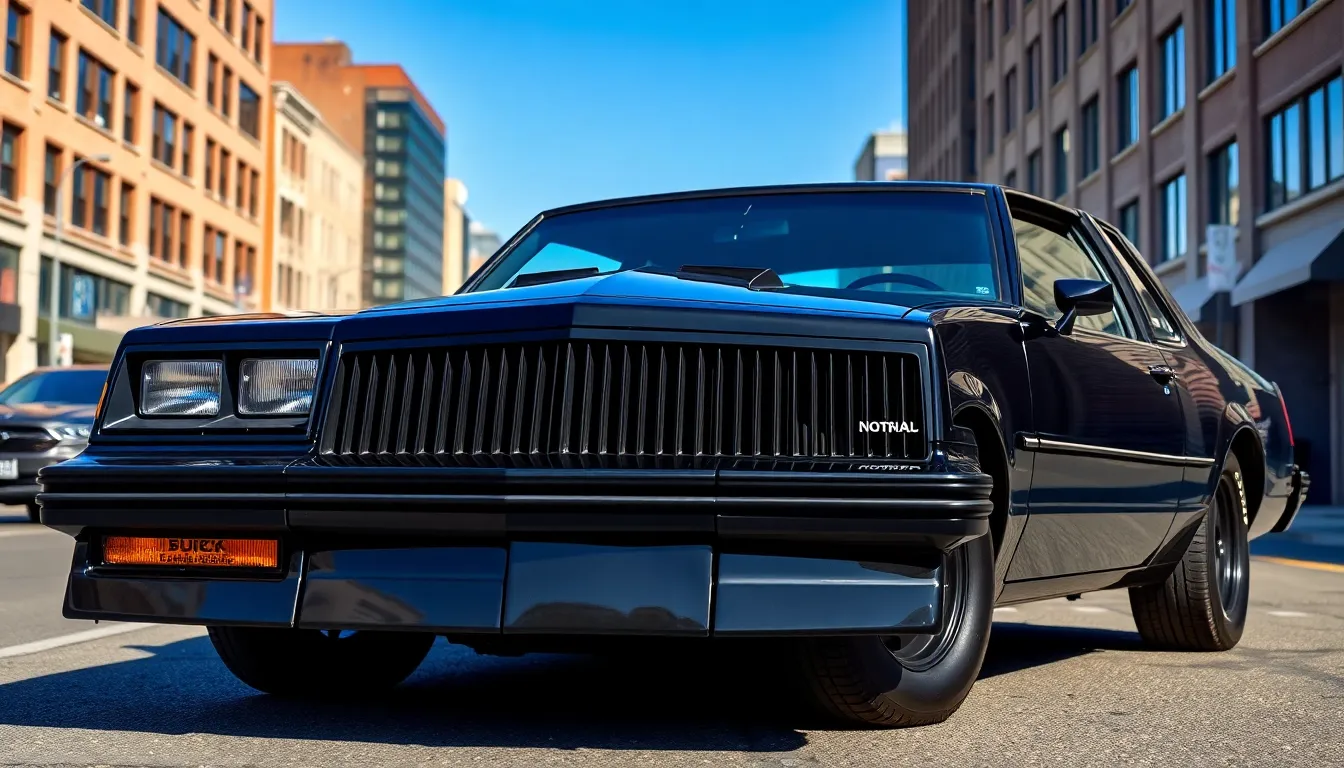
The Buick Grand National transformed automotive perceptions during its brief production run and continues influencing car culture decades after its final assembly. General Motors created something extraordinary when Buick engineers proved that turbocharged V6 power could outperform traditional V8 muscle cars, fundamentally changing how enthusiasts viewed forced induction technology.
Automotive Industry Influence
Buick’s Grand National demonstrated that American manufacturers could compete with imported performance cars using innovative engineering rather than displacement alone. The turbocharged 3.8-liter V6 engine’s success influenced other domestic automakers to explore forced induction applications in their performance vehicles. Ford’s subsequent turbocharged engines and GM’s continued investment in turbo technology trace their roots to the Grand National’s marketplace validation.
Performance metrics established new benchmarks for 1980s production cars. The Grand National’s 4.7-second 0-60 mph acceleration and 13.4-second quarter-mile times exceeded contemporary Corvette performance, forcing Chevrolet to enhance their flagship sports car. Insurance companies began recognizing turbocharged vehicles as distinct risk categories, leading to specialized coverage classifications that persist today.
Cultural Impact and Media Presence
Hip-hop culture embraced the Grand National as a symbol of success and power throughout the late 1980s and 1990s. Music videos featured the menacing black Buick prominently, with artists like Eazy-E and others showcasing Grand Nationals as status symbols. Movies including “Fast & Furious” franchise entries highlighted the car’s street credibility and performance capabilities.
Television appearances cemented the Grand National’s reputation among mainstream audiences. The car’s dramatic aesthetic and impressive acceleration made it perfect for chase scenes and dramatic entrances. Video games began including Grand Nationals in their racing simulations, introducing younger generations to this legendary performance machine.
Racing Heritage Continuation
NASCAR’s Grand National racing series provided the foundation for Buick’s production car success. The connection between track performance and street credibility established a template that manufacturers continue following today. Professional drag racers adopted Grand National platforms for competition, developing aftermarket support networks that remain active.
Grassroots racing communities embraced the Grand National’s potential for modification and performance enhancement. Quarter-mile times consistently dropped below factory specifications through aftermarket turbocharger upgrades and engine management improvements. Racing success validated the platform’s engineering excellence and demonstrated its untapped potential.
Modern Collector Recognition
Automotive historians recognize the Grand National as representing the final chapter of traditional American muscle car production before electronic intervention became standard. Classic car shows feature Grand Nationals prominently, acknowledging their historical significance and technological innovation. Automotive museums display preserved examples as representatives of 1980s performance engineering excellence.
Restoration specialists developed expertise specifically for Grand National maintenance and rebuilding. Parts reproduction companies emerged to serve collector needs, ensuring these vehicles remain roadworthy for future generations. Educational programs at automotive schools include Grand National case studies when teaching turbocharger technology and performance tuning principles.
Influence on Future Performance Cars
Modern turbocharged performance vehicles trace their conceptual DNA to the Grand National’s marketplace success. Manufacturers learned that forced induction could deliver impressive power while maintaining reasonable fuel economy ratings. The Grand National proved that black paint schemes and understated aesthetics could create more menacing presence than flashy graphics or bright colors.
Today’s muscle cars incorporate lessons learned from Grand National development programs. Turbocharger response characteristics, intercooler placement strategies, and engine management systems reflect technological advances pioneered during the 1980s Buick performance program. The Grand National’s legacy lives through every modern turbocharged performance vehicle rolling off production lines worldwide.
Conclusion
The Buick Grand National stands as one of automotive history’s most remarkable achievements. We’ve seen how this turbocharged legend defied expectations and created a lasting impact that extends far beyond its five-year production run.
Today’s collectors and enthusiasts continue to celebrate the Grand National’s unique blend of power sophistication and cultural significance. Its influence on modern performance cars remains undeniable as manufacturers still draw inspiration from its groundbreaking turbo technology.
For those considering ownership we recommend approaching the Grand National with respect for its engineering heritage and awareness of its maintenance requirements. Whether you’re drawn to its investment potential or simply want to experience automotive history the Grand National delivers an ownership experience unlike any other muscle car from its era.
Frequently Asked Questions
What made the Buick Grand National so special compared to other 1980s muscle cars?
The Grand National stood out with its turbocharged 3.8-liter V6 engine producing 245 horsepower, allowing it to outperform even the Corvette with a 0-60 mph time of 4.7 seconds. Its menacing all-black design, combined with exceptional performance during a time when muscle cars were considered dead, made it truly unique in automotive history.
How many Buick Grand Nationals were produced?
Buick produced only 20,193 Grand National units between 1982 and 1987, making it relatively rare. The even more exclusive GNX variant saw just 547 examples manufactured, contributing significantly to both models’ collectibility and current market values.
What is a Buick Grand National worth today?
Concours-quality Grand Nationals currently fetch between $85,000 and $120,000 at auctions, with values continuing to appreciate. The ultra-rare GNX variants command even higher prices due to their extreme scarcity. Low-mileage, well-documented examples represent the strongest investment potential in today’s collector car market.
What engine did the Grand National use?
The Grand National featured an innovative turbocharged 3.8-liter V6 engine with a Garrett T3 turbocharger and sequential fuel injection. By 1987, this engine produced 245 horsepower and 355 lb-ft of torque, delivering impressive acceleration and quarter-mile times that rivaled traditional V8 competitors of the era.
What are common problems with the Buick Grand National?
Common issues include turbo-related problems, transmission maintenance needs, and electrical gremlins typical of 1980s vehicles. The turbocharger system requires regular maintenance, and sourcing original parts can be challenging since Buick discontinued many components. However, strong aftermarket support helps address most maintenance needs.
Why is the Grand National culturally significant?
The Grand National became a cultural phenomenon, particularly in hip-hop music, movies, and television shows. It symbolized success and performance during the 1980s, transforming perceptions of both Buick and turbocharged engines. Its influence extended beyond automotive circles, making it an icon of American car culture.
How does the Grand National handle and drive?
The Grand National offers a unique driving experience with immediate power delivery once the turbo spools up. It features MacPherson strut front suspension and solid rear axle, providing predictable handling despite its weight. The four-speed automatic transmission includes manual shift capability, enhancing driver engagement and overall performance.

